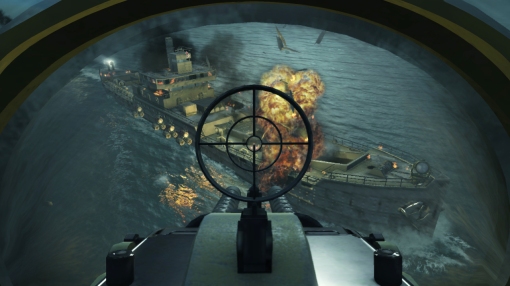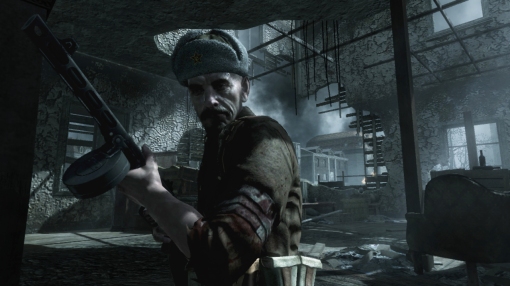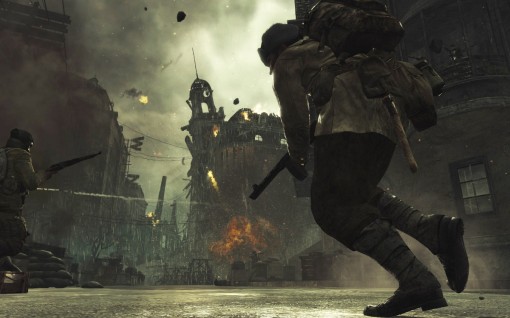Call of Duty World at War – “Call of Duty four World War II”
If there’s anything that sticks out in the “Call of Duty” series, is its focus on delivering a thrilling, cinematic in-your-face depiction of war. It’s not by chance that the first major inspiration for the series was Steven Spielberg’s opus of the Normandy landing in “Saving Private Ryan”: the shaking of the camera, blurring the gritty colors of war-machines and destroyed landscapes, with red sprouts of blood emerging in the bloody onslaught of human life, bullet by bullet, explosion by explosion… limb by limb, man by man. Capturing that chaotic experience of horror and sacrifice is the kind of thing you’d expect games would be known and respected for. But it isn’t, and we all know that. In that sense, “Call of Duty” was definitely a small step forward. Firstly, with its audiovisual fidelity, which successfully established the same atmosphere that Spielberg’s film became known for. Secondly, because the game adapted the classic FPS formula to the war context. Most FPS games forced you to go for point A to point B, while obliging you to, single-handily, kill every possible enemy in sight. “Call of Duty” (like its predecessor “Medal of Honor: Allied Assault”) opted to encompass the player in an army, making him choose ways in which to avoid direct confrontation with enemies, through flanking and the use of indirect fire. Also, player’s comrades take some of the burden into their hands, killing a considerable amount of enemies. Stripped to its barest, “Call of Duty” forces the player to accomplish a certain objective (break a defense line, clear a location of enemies, plant a bomb, protect a convoy), but framing in it in a convincing way that doesn’t make it (too) ridiculous. You still play a hero like in most shooters, but it isn’t a lonely or utterly invincible hero. “Call of Duty 4” tuned the series’ formula to near perfection, by harmoniously weaving Level, Art and Sound Design to produce a rising tension in each set piece, and in the overarching experience. It was still the same game, but the audacity and scale of its confrontations, coupled with great cutscene directing, made its campaign a glorious ode to war… in a videogame-y kind of way. “World at War” is the same. No more, no less. It stumbles in the same faults as its predecessor, and can be lacking in some of the more creative assets which made it a success, but “World at War” really is “Call of Duty 4″… in a World War II scenario.
Using the same narrative vehicles as its predecessors, “World at War” presents each set piece by utilizing snazzy power-point-ish presentations, as your ranking officer briefs you in on the details concerning the upcoming battle. You get to experience two campaigns: one in which you fight on the pacific front to crush the Japanese armada, following the steps of a traditional American style hero, the compassionate, yet tough Seargant Roebuck, played by Kiefer ‘Bauer’ Sutherland in his already cliched monotonic voice; the other storyline, more interesting and provocative, places you as the right-wing man of Seargant Reznov, a vindictive, cruel hearted Soviet, who seeks revenge against the Germans for the destruction of Stalingrad. It’s immediately clear that the first campaign is more of the same epic set pieces in which great American heroes go about freeing the world from the dreaded enemy, in this case, the Japanese, herein portrayed as vicious monsters bent on winning a war at all costs, whether it involves sneaking techniques, kamikaze attacks or plain old backstabbing. You’d think that in a war, killing would be a despicable act whichever the surrounding conditions, but apparently the Japanese kill in an “evil” way. The Soviet campaign is more original, as it does try to portray a different side of the war. The Soviets are depicted as more realistic characters, in the sense that their personalities reflect the unquestionable fact that they are fighting a bloody war. They are ruthless and moved by selfish goals, unbent by hypocritical notions of moral or military conduct, which ends up making their campaign more truthful and moving… and of course, Gary Oldman’s amazing voice-work can really make you wanna go kill some Nazi scourge. However, it needs to be pointed out that in both plot-lines, the subjectivity of American perspective is prevalent, so expect a great deal of prejudice, xenophobia, social, and historical inaccuracies. Like Churchill said, History is written by the victors.
As you’re thrust into the battlefield proper, you get to presence everything in first person, your presence diluted with that of the mute and otherwise irrelevant main character. The action unfolds on screen just as it did in “Call of Duty 4”, in which the barrier between cutscene and gameplay was blurred to a degree which made you wonder if you could change the course of certain events. Some you can and some you don’t, which doesn’t really matter since it never really changes how the story ultimately unfolds. It’s a bit less linear for that, and it adds to the notion of immersion and false choice that helps create a sense of a credible world. Because the transition between story and action is seamless, the breathtaking action pieces are made all the more emotional for it, especially in the Soviet Campaign. From Stalingrad to Berlin, you’ll be in constant awe with the scale of each war set, fleshed out by a beautifully crafted mise en scène, courtesy of the Infinity Engine, which once again provides the same ambient lighting and particle effects that made “Call of Duty 4” so visually captivating. The final showdown in Berlin gives a whole new meaning to the concept of destroyed beauty, as you endure the ravishing of the opulent Reichstag, covered in smoke, dust and flames, a stark palette of death and war covering the landscape. Trust me when I say that images don’t do it justice [for some strange reason, I could only find one image that accurately represented the graphics of the game (the one above, click on it to see it in high-res), as all of the images available on the net are blurred out or badly compressed; so sorry about that]. But the multitude of moody color palettes can only serve as background for the cacophony of raining bullets, explosions and frenetic shouts of pain and camaraderie. Once again, the soundtrack steals the show, thanks to its pitch perfect fidelity, and the smart use of musical crescendos to enhance the epic grandeur of war. The score (by Sean Murray) is still a competently mixed miscellany of electronic, industrial, metal and classical sonorities that successfully punctuate the emotional impact of the game. And yet again, the Soviet portions of the soundtrack are the best: you simply cannot beat the visceral impact of a beautifully orchestrated chorus.
Despite the arresting power of the “Call of Duty” games, they still have a long road ahead in terms of creating meaningful and realistic war experiences. Their more important fault still lies in their dramatic core. Though the Soviet Campaign does take it a step forward, by trying to introduce nuanced characters, the series is still lacking when it comes to true drama, because it has no real characters, subtext or emotion. And “Call of Duty” does need drama to make the experience feel genuine, because the essence of war is death and loss, and the emotional responses associated with those events are missing. Only when the player hesitates before mindlessly shooting an enemy, or resents his inability to save a comrade, will the War FPS genre achieve plenitude. Unfortunately, the series never went in that direction, and continues to lethargically tread in its own FPS convention laden path. But, even forgetting any aspirations the series’ authors dismiss, the fact is that this episode doesn’t improve the series one bit, allowing easy to fix flaws to maintain one more year. The most glaring of which is the stubborn use of a noisy, aesthetically displeasing HUD… a baffling notion for a 2008 top tier game that puts so much weight on immersion. And though it can be useful in terms of helping the player move along, there are a number of available alternatives that don’t break up immersion (see “Peter Jackson’s King Kong” game). Just imagine “Saving Private Ryan” with golden stars, numbers and icons flying about the screen like in a football match transmission; if that doesn’t remind you that “Call of Duty” is a game, as opposed to a 1st person war-experience, then nothing does. And sure, there are still AI problems, level design model eccentricities that need fixing, and the overall sense that this is just one more World War II FPS. But, truth be told, forgetting the game’s lack of originality can be simple while playing the game. It’s just entertaining, and sadly, in this medium that’s really all it needs to be. Personally, I’m still wishing they can someday come up with a dramatic first-person experience that is akin to “Saving Private Ryan”… in more than just the aesthetic qualities of the film. But I know, it’s a hopeless dream.


